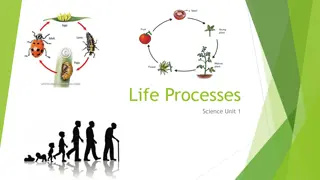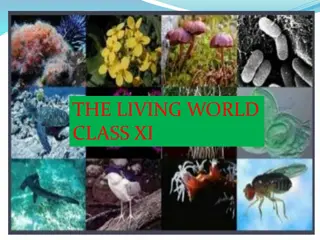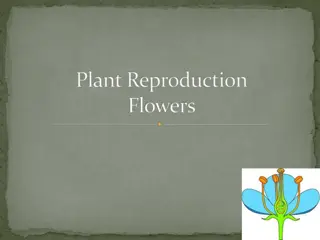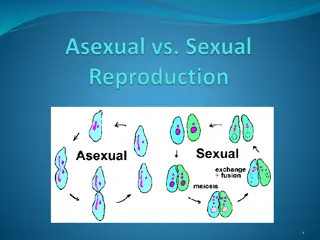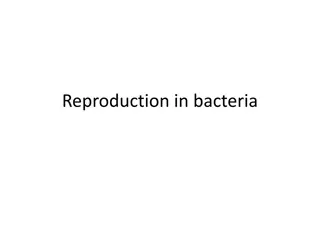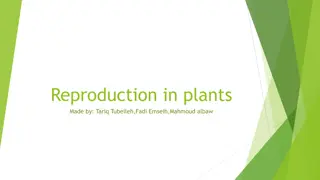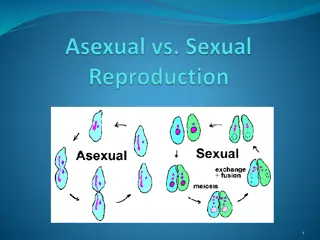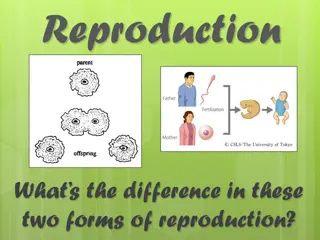Understanding Different Types of Reproduction in Organisms
Unwanted materials can be passed directly or indirectly, impacting the complexity of systems and bodies. Reproduction methods include sexual and asexual, each with unique processes and characteristics. Asexual reproduction involves division and growth, while sexual reproduction combines hereditary information from gametes. Various organisms demonstrate different types of asexual reproduction, such as budding and spore formation, for survival in varying environments.
Download Presentation

Please find below an Image/Link to download the presentation.
The content on the website is provided AS IS for your information and personal use only. It may not be sold, licensed, or shared on other websites without obtaining consent from the author. Download presentation by click this link. If you encounter any issues during the download, it is possible that the publisher has removed the file from their server.
E N D
Presentation Transcript
unwanted materials can be passed directly or indirectly to the outside complexity of the system increased with complexity of the body in
contain in nucleus in the cytoplasm. The nucleus controls all cellular activities. Living things have the ability to reproduce their kind, for the survival of the specie. There are two methods of reproduction
Sexual reproduction in the production of new individuals with a combination of the hereditary information of two different cells i.e. gametes
Asexual reproduction that is the formation of offspring without the union of gametes.
The following are the different types of asexual reproduction:
divide into two roughly equal halves and grow to full size. The process is continuously repeated. Amoeba does it every 20-30 minutes. Merozoites of plasmodium exhibit multiple fission known as schizogony.
before separating from parent. In hydra (multicellular), a projection of many cells from grows develop, tentacles and other adult features before pinching off. The tapeworm buds off mature proglottides. Rhizomes and stolon are found among plants. Miniature leaves are found in the margin of Bryophyllum.
protected and dormant state in unfavourable periods. Some bacteria are spore formers. In chlamydomonas, the cell content divides 1-3% to give 2 to 8 zaoospores, each with a nucleus and 2 flagella. Each grows to become adult. The fungi are prolific spore producers. The mosses, club mosses and ferns use spores to disperse.
break into 8 or 9 parts which grow into adult. Fragmentation usually depends on external forces e.g. waves break up green and brown algae at sea shore spirogyra breaks to regenerate fragment lost. Man makes cuttings of plants to produce more.
found in the nucleus residing on the chromosomes. They are distributed to daughter cells through the process of mitosis. Chromosomes are tenuous when not dividing (interphase) and are known as chromatins. They are active in RNA synthesis and shortly before mitosis, DNA systhesis. Mitosis is divided into 4 stages. individual centromeres. The centromeres arrange exactly on the equatorial plate. Prophase: chromosomes appear. The nuclear membrane disappears. Chromosomes coil up, becomes shorter and thicker. They appear double and joined at the centromere. Metaphase: The spindle fibres extens between the poles of the cell attaching to The nucleolus disappear and
Anaphase: Centromeres duplicate, separate and move to opposite poles. Telophase: Chromosomes are at the poles, uncoil and coalesce. Nucleolus appear, nuclear membrane also. The cell plate appears at the equator and gradually a cell wall is secreted in plants. In animals, a furrow in the cell membrane forms at the equator to divide the cell.
gametes could appear similar, e.g. isogametes of Chlamydomonas. Individual chlamydomonas cells divide 4 or 5 to give 16 to 34 isogametes. The cell wall breaks to release them and these fuse with the gametes of another cell to form a zygospore.
the egg). The female gamete, the egg, is larger and non motile with substantial quantities of cytoplasm for the developing embryo. Such gametes are said to be heterogametes. Fertilization of heterogametes gives zygote i.e. a fertilized egg. These involve 2 individuals combining to give new characteristics.
One strain is deficient in the ability to synthesize vitamin B, Biotin and amino acid. Methionine: Another strain produces the above but not the B vitamin; thiamine and amino acids; threomine and leucine. The two strains require the deficient substances to grow. But if both are mixed and plated on a medium colonies develop and survive even in the absence of the vitamins and amino acids their parents require to grow. This shows the simplest
as gametes, zygotes will have double the number of the parents. Meiosis corrects this by reducing the chromosome number in cells become gametes (germ cells) to half. It goes by duplicating an homologous pair and then separating into four daughter cells each with the haploid number of chromosomes. So that a zygote will have the 2ndnumber.
1 Meiotic Division: Prephase is slower and shorter synapsis occurs in each homologous paid and an exchange of parts between the members.
Metaphase: Centromeres of homologous pair are arranged on the equatorial plate and attached to the spindle.
Anaphase: Each centromere moves towards opposite poles. No duplication of members ocfcurs.
Telephase: Two daughter cells with a member of each homologous pair of chromosomes.2ndMeiotic Division: Starts immediately or a little after 1 meoisis.
Prophase: Each chromosome is still a doublet with non-identical members.
Metaphase: Each chromosomes moves to the equatorial plate, attached to the spindle. They are duplicated.
Anaphase: Daughter chromosomes separate and move towards poles.
produced with one member of a pair of chromosomes i.e. haploid. There are two cells with chromosomes of either of the parents and two with chromosomes containing both maternal and paternal parts.
When n = 2 we have 2 different combination (21)
n = 4 we have 16 different combinations (2+) etc.
This random assortment coupled with crossing over, makes total similarly between two individuals quite different.
Meiosis reduces chromosome number and creates variability, even between two gametes of same individual.
Asexual reproduction produces offspring like parents while sexual reproduction produces variant offspring.
GAMETOGENESIS OR GAMETE FORMATION
Spermatogenia may divide to produce more or be transformed into primary spermtocytes after some growth. 1stmeiotic division follows to give secondary spermatocytes 2ndmeiotic division occurs to give spermatids. Each spermatid differentiates into a spermatozoon with almost all cytoplasm lost.
almost completed. Only one oogonial cell grow into a primary cocyte, surrounded by a layer of cell sin follicle. The others degenerate. At puberty, one egg (ovum) is released monthly. After release as primary cocyte, it undergoes 1stmeiotic division. Secondary oocyte and small polar body are produced. The second meiotic division of the secondary cocyte gives the only functional egg (plus another polar body).
the ovary. The anther contains the pollen mother cell called microsporocytes which are diploid. Each undergoes meiosis I and II to give rise to four microspores which are haploid. Each spore nucleus undergoes metotic division without cytokinesis. One is the generative nucleus and the tube nucleus. This cell develops into pollen grains i.e. miucrogametophyte. After the pollen grain is placed on the stigma, the nuclei move into the
haploid nuclei. The cell is the embryo sac. Three of the 8 nuclei migrate to the chalaza and of the embryo sac (opposite to the opening 0 micropyle) and 3 to the micropylar end. The middle nuclei of the 3 at micropylar end becomes the functional egg and the two the synergids. Those at the chalaza end are called antipodal cells. They usually degenerate. The two at the centre are the polar nuclei. One of the two nuclei from the
organism arising from the synthesis of new structural material using the energy provided by respiration and raw materials from outside the organism.
During growth, the amount of cytoplasm generally increases, causing an increase in length, volume, area or weight of the organism.
profound changes called metamorphosis seen in insects and amphibians. The overall growth of multicellular organisms is achieved by increase in the number of body cells as a result of cell division, this is accompanied by increase in size of individual cells by cell growth. When the rate of anabolism is greater than the rate of catabolism, the organism will show growth. When catabolism exceeds anabolism the organism will show a


